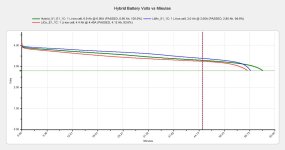CanadianWinters
100 W
Hi everyone.
Some weeks ago I purchased some Makita BL1830 packs from a ES member.
I tested and recovered them and then made a 15s4p (55.5v 6Ah nominal--->60 cells) pack and tried it on my ebike. It worked great!
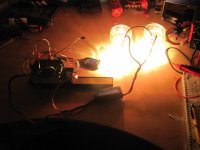
I then decided to dismantle my 10s12p li-ion pack made with laptop cells and make a hybrid battery with the Makita cells.
I made a 15s3p (55.5v 6Ah nominal -->45 cells) with the laptop cells.
Charged both packs to the exact same voltage (62.0v) and then connected them in parallel.
It took me a lot of time to dismantle the 10s12p pack and rebuild it to fit the battery box but I am pretty happy with the result.
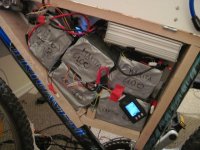
I also added a pre-charge/anti-spark resistor (380ohm 3.75W), so far works great on different setups:
View attachment 4
Bike data:
*Rear Bafang 500W high torque from BMSbattery
*26" wheels
*30 Amps (32Amps in reality) 36v KU123 controller (63v caps inside)
*GT power meter 130A max (read max 60V but I've been lucky, reads my 62v !!)
So I took the bike out for a ride today. Unfortunately I only have 2 Cell-log 8s so I can log the data only from 5 cells of the makita pack and 5 from the laptop pack.
During the ride pedalling was 0%.I tried to go WOT all the time but I was going too fast on the bike path. It was lots of fun, very quick acceleration. I am pretty impressed with the results, after 10km I still hit 40kph+ no problem.
Data:

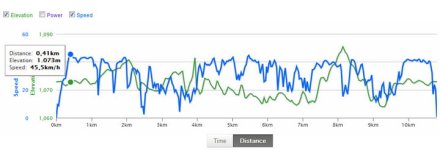
Notice 45.5kph after 400m (a little downhill though)
Laptop cells log:
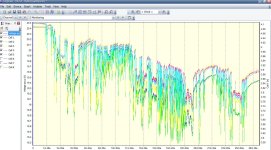
Here I seem to have a problem with a weak laptop cell.
Makita cells log:
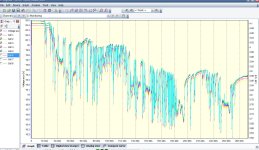
So far I am pretty impressed with the results. I am not sure about the voltage under load. I read 53.5v during acceleration in the last km of the ride, quickly climbing up to 56-57v (I wish I had a camera to re-view what happened).
What is the safe limit?
Some weeks ago I purchased some Makita BL1830 packs from a ES member.
I tested and recovered them and then made a 15s4p (55.5v 6Ah nominal--->60 cells) pack and tried it on my ebike. It worked great!

I then decided to dismantle my 10s12p li-ion pack made with laptop cells and make a hybrid battery with the Makita cells.
I made a 15s3p (55.5v 6Ah nominal -->45 cells) with the laptop cells.
Charged both packs to the exact same voltage (62.0v) and then connected them in parallel.
It took me a lot of time to dismantle the 10s12p pack and rebuild it to fit the battery box but I am pretty happy with the result.

I also added a pre-charge/anti-spark resistor (380ohm 3.75W), so far works great on different setups:
View attachment 4
Bike data:
*Rear Bafang 500W high torque from BMSbattery
*26" wheels
*30 Amps (32Amps in reality) 36v KU123 controller (63v caps inside)
*GT power meter 130A max (read max 60V but I've been lucky, reads my 62v !!)
So I took the bike out for a ride today. Unfortunately I only have 2 Cell-log 8s so I can log the data only from 5 cells of the makita pack and 5 from the laptop pack.
During the ride pedalling was 0%.I tried to go WOT all the time but I was going too fast on the bike path. It was lots of fun, very quick acceleration. I am pretty impressed with the results, after 10km I still hit 40kph+ no problem.
Data:


Notice 45.5kph after 400m (a little downhill though)
Laptop cells log:

Here I seem to have a problem with a weak laptop cell.
Makita cells log:

So far I am pretty impressed with the results. I am not sure about the voltage under load. I read 53.5v during acceleration in the last km of the ride, quickly climbing up to 56-57v (I wish I had a camera to re-view what happened).
What is the safe limit?


![IMG_0489[1].JPG IMG_0489[1].JPG](https://endless-sphere.com/sphere/data/attachments/49/49436-8ed4a7fdcf03bcce3695c2e378996218.jpg)









